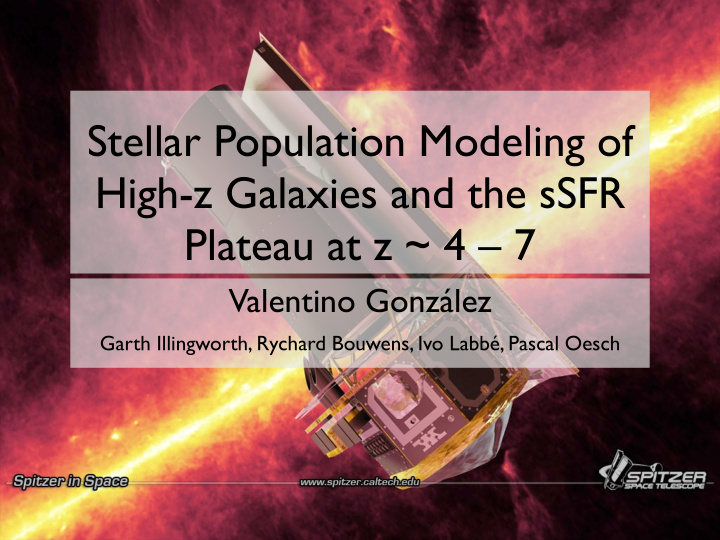



Stellar Population Modeling of High-z Galaxies and the sSFR Plateau at z ~ 4 – 7 Valentino González Garth Illingworth, Rychard Bouwens, Ivo Labbé, Pascal Oesch
Spitzer /IRAC provides valuable constraints to estimate Age and Stellar Mass. ⇐ ACS ⇒ ⇐ ACS ⇒ ⇐ WFC3 ⇒ ⇐ WFC3 ⇒ ⇐ IRAC ⇒ z ~ 7 Log M = 7.6 – 9.0 M ⊙ ?
Indication of evolved Stellar Population even at the highest redshifts probed (or not?) ⇐ ACS ⇒ ⇐ WFC3 ⇒ ⇐ IRAC ⇒
Stellar Mass is “fairly” robust but still dependent on assumptions used in SPS model fitting. ⇐ ACS ⇒ ⇐ WFC3 ⇒ ⇐ IRAC ⇒ Caveats to have in mind: IMF alone can be a factor x2. Dust-Age degeneracy. SFH?
The median-stacked SEDs are remarkably similar in the range z~4–7 z~4 z~5 z~6 z~7 Gonz á lez et al. in prep.
At a given UV luminosity, the M/L ratio is roughly constant. Requires adequate dust corrections. Gonz á lez et al. (2010)
Latest measurements of β to estimate E(B-V) (using, e.g. , Meurer et al. ‘99 relation) Bouwens et al. in prep.
Bouwens et al. in prep.
This is still a rather simple correction to the previous results. Bouwens et al. in prep.
The Stellar Mass Functions
The Stellar Mass Functions as of 2009. Data on individual sources not deep enough. M 1500,AB > –20 Stark et al. (2009) Finlator et al. (2010) Choi & Nagamine (2010) Individual masses for bright sources and stacking for the faint end.
At a given redshift, the SED varies with luminosity. Reflected in the the M/L ratio vs UV luminosity. z~4 Gonz á lez et al. (2011) Lee et al. (2011) and Gonz á lez et al. in prep.
Combine with the UV-LF to derive Stellar Mass Functions • UV-LF are deep. • Contamination corrections. • Completeness corrections. This is very hard to replicate for a Mass selected sample. Bouwens et al. (2007,09,11)
The Stellar Mass Functions as of 2009. Data on individual sources not deep enough. M 1500,AB > –20 Stark et al. (2009) Finlator et al. (2010) Choi & Nagamine (2010) Individual masses for bright sources and stacking for the faint end of the M/L vs L UV relation.
The Stellar Mass Functions z~4 z~5 z~6 z~7 Gonz á lez et al. (2011)
The Stellar Mass Functions z~4 z~5 z~6 z~7 Gonz á lez et al. (2011)
Are we really seen Balmer Breaks? Emission lines are expected, especially for rising SFHs. Is the rest-frame optical dominated by these emission lines? (Schaerer and de Barros 2009, 2010)
• At z~3.8 – 5.0 H α contaminates the [3.6] channel of IRAC while [4.5] remains fairly clean. • Requires spectroscopic redshifts. • Shim et al. (2011) finds 2.5 continuum at [4.5] f 3.6 μ m / f 4.5 μ m • Also look for [3.6] 2.0 1.5 excess over [4.5]. Some 1.5 sources show signs of 1.0 very strong H α 0.5 SDSS QSO emission. cB58 stellar cont. (cB07) 0.0 3.5 4.0 4.5 5.0 Redshift Shim et al. (2011)
If continuum dominated plus emission lines, the picture largely holds. continuum dominated But notice that Ages, Stellar Masses, sSFR will require adjustments (possibly factors x1.5-2). Other uncertainties remain: Dust, SFH, Metallicity.
Summary • Spitzer/IRAC provides valuable constraints to estimate Stellar Masses and M/L UV ratios. • The median SEDs (rest-frame UV to Optical ) of z~4–7 star forming galaxies are remarkably similar. • Latest dust estimates provide update to sSFR plateau especially at z~4-5 (considerable uncertainties in the modeling remain). • Variable M/L UV ratio + UV Luminosity Functions ⇒ Steep Mass Functions (slopes ~-1.45). • Models: good agreement at massive end but models over-produce number of low mass sources • Emission lines are probably present and corrections will be required (extreme emission line dominated models?). • Several other uncertainties remain: SFH, metallicity, dust, IMF.
Recommend
More recommend